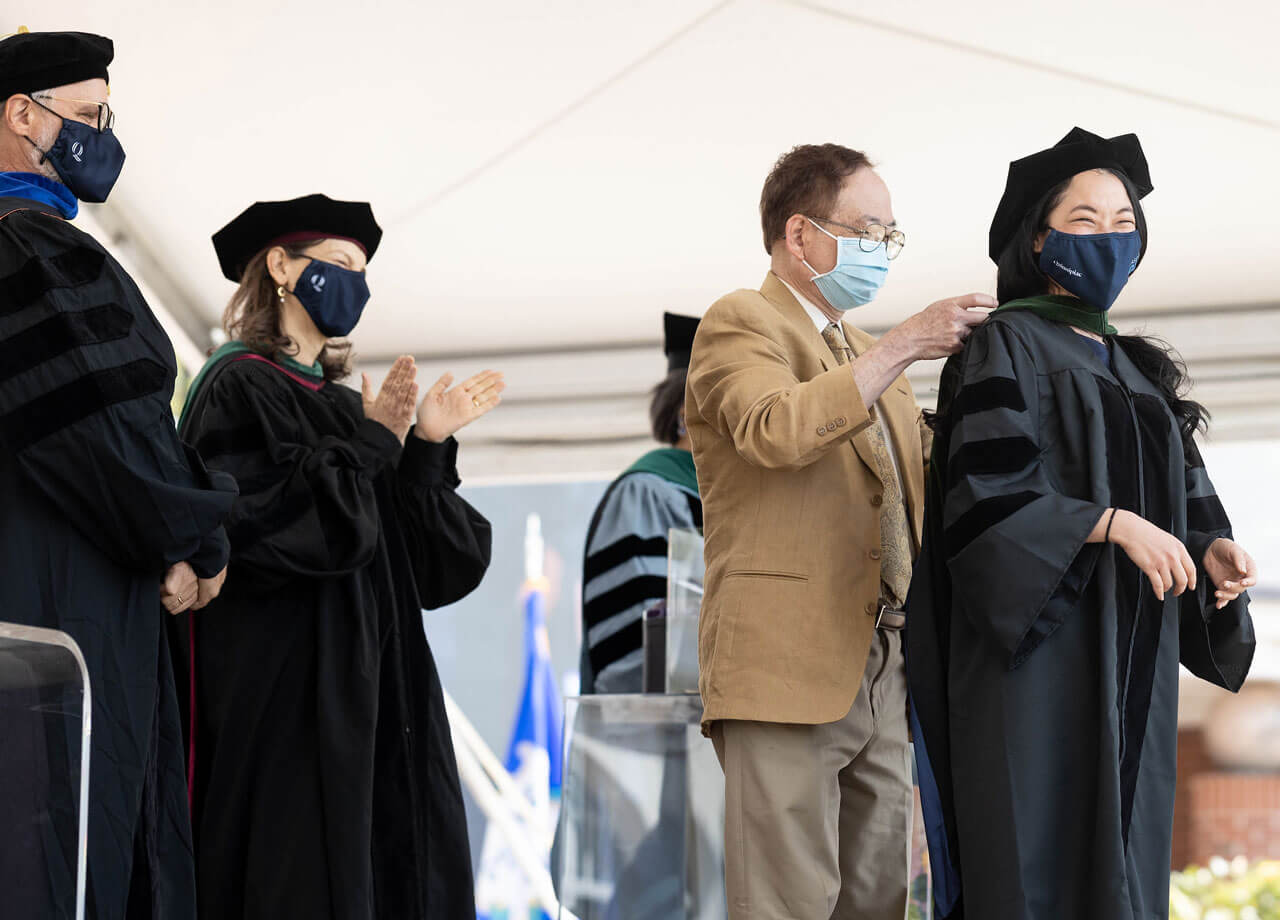
Class of 2021 Frank H. Netter MD School of Medicine Commencement


Lisa Sanders, a physician, professor and New York Times columnist, told the Class of 2021 “to be the doctor of your dreams” Tuesday at Commencement exercises for the Frank H. Netter MD School of Medicine.
“You’re at a point in your career when you need to go from automatic pilot to the manual controls,” Sanders said. “It’s time for you to take charge of your mind, your heart, your very soul, and certainly, your career. In order to be the doctor of your dreams, you’re going to have to fight for it. Your patients need that doctor. But just as importantly, so do you.”
In total, 95 medical doctor degrees were conferred on the Mount Carmel Quad. In addition, four medical school students graduated from the Master of Medical Science Anesthesiologist Assistant program.
President Judy Olian praised the Class of 2021 graduates for its commitment to each other and the community.
“Throughout the pandemic, you’ve given back to our neighbors and local communities in a myriad of ways,” Olian said. “As our state and nation grappled with the spread of COVID-19, your medical instincts kicked in — you connected with vulnerable seniors who were feeling isolated, and helped create and distribute PPE.”
“I am so proud of you,” she added. “Please remain a Bobcat for life, and know you’ll always have a home here at Quinnipiac — and we hope you will come back to your home away from home often.”
Bruce Koeppen, founding dean of the Frank H. Netter MD School of Medicine, was also celebrated during the ceremony. Koeppen is retiring this summer after a nearly 40-year career in academic medicine.
“Today is also a time of transition for me. This is my last Commencement ceremony at Netter,” said Koeppen, his heartfelt words trembling with emotion.
“When our inaugural class — the Class of 2017 graduated — they were described as heroic for taking the chance on this brand-new medical school,” Koeppen said. “They were called resilient and adaptable, as together, we worked through our growing pains. By comparison, you — the members of the Class of 2021 — were and are heroic, resilient and adaptable beyond description.”
Provost Debra Liebowitz, who opened the Commencement, lauded the graduates as well.
“You have completed your medical studies in the midst of unprecedented times, and continually showed resiliency and grit — while always rising to every challenge that has come your way,” Liebowitz said.
Tiffany Rose, MD ’21, sang the national anthem at the ceremony. Sneha Alaparthi, MD ’21, delivered the student remarks for the class.
“There may still be times in our lives when we feel the victim of circumstance,” Alaparthi said. “To this I reply: Take a moment for yourself, lean on your loved ones, remember your Netter connections and then remember: Why not me?”
Learn more about the School of Medicine

Processional
Pomp and Circumstance, Sir Edward Elgar
Call to Commencement
Debra J. Liebowitz
Provost
National Anthem
Tiffany Rose, MD '21
Greetings
Judy D. Olian, PhD
President
Dean’s Remarks
Bruce M. Koeppen, MD, PhD
Dean of the Frank H. Netter MD School of Medicine
Introduction of Commencement Speaker
Bruce M. Koeppen
Commencement Address
Lisa Sanders, MD, FACP
Associate Professor of Medicine, Yale School of Medicine
New York Times Columnist, Diagnosis
Presentation of Anesthesiologist Assistant Candidates for Degrees
A. William Paulsen, MMSc, PhD
Professor of Medical Sciences and Anesthesiologist Assistant Program Director
Conferral of Degrees
Judy D. Olian
Presentation of Candidates for Medical Degrees and Conferral of Hoods
Kim-Thu C. Pham, MD, MPH
Associate Dean, Student Affairs
Conferral of Degrees
Judy D. Olian
Student Remarks
Sneha Alaparthi, MD ‘21
Hippocratic Oath
Lyuba Konopasek, MD
Senior Associate Dean of Education
Recessional

Associate Professor of Medicine, Yale School of Medicine
New York Times Columnist, ’Diagnosis‘
Lisa Sanders is an internist on the faculty of the Yale School of Medicine and teaches in the internal residency program there. She created and writes the biweekly “Diagnosis” column for The New York Times Magazine and is the author of “Diagnosis: Solving the Most Baffling Medical Mysteries,” a collection of those columns that served as the inspiration for the popular TV series, “House M.D.” She was an adviser to the show. Working with the Times and producer Scott Rudin, Sanders helped create a series of Netflix documentaries that followed patients in their search for a diagnosis using crowdsourcing. Sanders also wrote a New York Times bestseller, “Every Patient Tells a Story: Medical Mysteries and the Art of Diagnosis.” Before she attended medical school, she was an Emmy Award-winning producer for CBS News. She graduated from Yale School of Medicine and did her residency and chief residency at Yale’s Internal Medicine Primary Care program.
The 12th and 13th centuries saw the formation of universities under the jurisdiction of the Church. Most students of the day were clerks in the Holy Order, monks or priests. Cowls or hoods adorned their habits and protected the young scholars from harsh weather and the pervading dampness of the stone buildings in which they studied. Hoods also served to cover tonsured heads before the use of the skullcap.
Today, the cap, gown and hood have taken on a symbolic meaning. Color and shape conform to an academic code signifying a university’s conferral of the degree and the nature of the degree conferred. Gowns for the doctoral degree carry velvet panels and three horizontal velvet bars on the upper arm of the full, round, bell-shaped sleeves.
The mace — a symbol of authority — has antecedents in both Roman and Medieval history. The Roman mace (fasces) was carried by a lictor before the chief magistrate of the city, as well as before the legions. During the Middle Ages, the mace (mateola), a weapon of war, became first a symbol of victory and then a symbol of authority. The mace emblazoned with the Great Seal of England became a symbol of authority in Parliament by the end of the 13th century. It is this form of the mace that was the prototype of those symbols of authority, not only of legislative bodies, but also of cities and universities.
In 1246, following some 20 years of strife, the University of Paris was finally conceded the right to its own common seal. Since then, the use of the seal engraved on the mace has come to symbolize the authority of the academic community. In July 2000, Quinnipiac commissioned the noted sculptor Robert Meyer of Westport, Connecticut, to design and execute a new mace for Quinnipiac University. Cast in bronze, the mace incorporates elements of the university seal.
The medallion (medal of office), like the mace and the seal, is also a symbol of authority. It is possible that its roots may be traced back to the Roman “bulla” (a gold amulet of honor). The obverse of the medallion shows the seal of the office the wearer holds — in our case, the seal of the university. Not infrequently, the reverse would show the personal seal or coat of arms of the bearer. Since the High Middle Ages, the medallion has been worn by such officials as the chancellors of England, mayors of cities, and rectors of universities, and came to signify the high personal position such figures occupied in their respective governments. During the Renaissance, medallion design reached unique artistic heights, and in certain portraits the medallion was given particular prominence. The medallion is worn by the university’s president. The Quinnipiac medal showcases the university seal, sculpted in relief and cast in bronze.
Bruce M. Koeppen, MD, PhD Dean
Charles Collier, MS, Assistant Dean for Health Career Pathways
Lisa Coplit, MD, Associate Dean for Faculty Development
Lyuba Konopasek, MD, Senior Associate Dean for Education
Scott Kurtzman, MD, Assistant Dean for Graduate Medical Education and Designated Institutional Official
Traci Marquis-Eydman, MD, Assistant Dean for Faculty Engagement
Doug McHugh, PhD, MBA, Assistant Dean for Curriculum
A. William Paulsen, MMSc, PhD Program Director for Anesthesiologist Assistant Program
Kim-Thu Pham, MD, MPH, Associate Dean for Student Affairs
Jennifer Rockfeld, MD, Assistant Dean for Curriculum
Richard Stahl, MD, Senior Associate Dean for Strategic Relationships
Listy Thomas, MD, Assistant Dean of Simulation
Mark Yeckel, PhD, Associate Dean for Admissions
Richard Zeff, PhD, Chair of Medical Sciences, Senior Associate Dean for Scholarship
Get the latest news and events sent right to your email by subscribing to Quinnipiac Today.
Subscribe